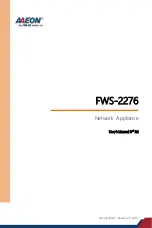
FortiGate-800 and FortiGate-800F FortiOS 3.0MR4 Install Guide
22
01-30004-0269-20070215
Factory defaults
Factory default NAT/Route mode network configuration
When the FortiGate unit is first powered on, it is running in NAT/Route mode and
has the basic network configuration listed in
Table 5 on page 22
. This
configuration allows you to connect to the FortiGate unit web-based manager and
establish the configuration required to connect the FortiGate unit to the network.
In
Table 5 on page 22
, HTTPS administrative access means you can connect to
the web-based manager using HTTPS protocol through this interface. Ping
administrative access means this interface responds to ping requests.
Table 5: Factory default NAT/Route mode network configuration
Administrator
account
User name:
Password:
admin
(none)
IP:
192.168.1.99
Internal interface
Netmask: 255.255.255.0
Administrative Access: HTTPS,
Ping
IP:
192.168.100.99
External interface
Netmask:
255.255.255.0
Administrative Access:
Ping
IP:
10.10.10.1
DMZ interface
Netmask: 255.255.255.0
Administrative Access: HTTPS,
Ping
IP: 0.0.0.0.
HA
Netmask:
0.0.0.0.
Administrative Access:
Ping
IP: 0.0.0.0.
Port 1
Netmask: 0.0.0.0.
Administrative Access:
Ping
IP: 0.0.0.0.
Port 2
Netmask:
0.0.0.0.
Administrative Access:
PIng
IP: 0.0.0.0.
Port 3
Netmask:
0.0.0.0.
Administrative Access:
Ping
IP: 0.0.0.0.
Port 4
Netmask: 0.0.0.0.
Administrative Access:
Ping
Default Gateway (for default route)
192.168.100.1
Default Route
A default route consists of a default gateway and the name of
the interface connected to the external network (usually the
Internet). The default gateway directs all non-local traffic to this
interface and to the external network.
Network settings
Primary DNS Server:
65.39.139.53
Secondary DNS Server:
65.39.139.53
















































